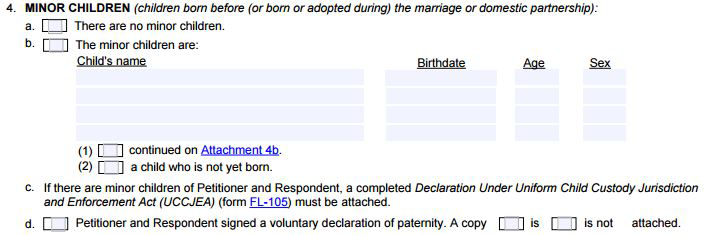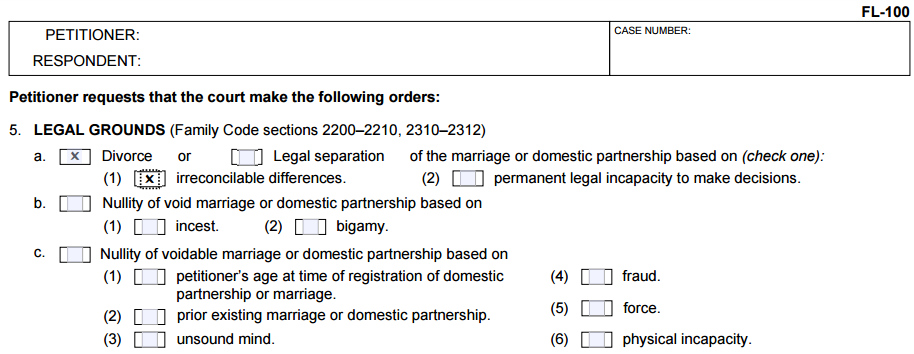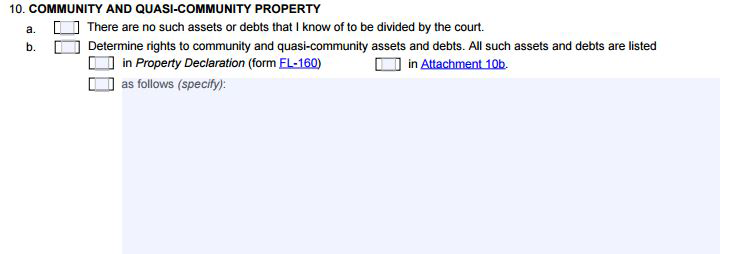Petitioner without Children
California Divorce Form FL-100
The Petition (FL-100) begins the divorce process.
We’re going to dive right in and get started with the beginning forms needed to start your divorce process, starting with form FL-100. In case you’re wondering, all of the family law forms start with “FL,” (FL standing for “family law”). This form was updated for 2015 and slightly modified again in 2016, but the changes do not affect any of the questions or required fields that you’ll be completing.
For the purposes of completing these forms, we will have a sample couple. The husband, John Smith, will be the petitioner, and his wife, Jane, will be the respondent. John lives at 124 Rose Street in San Ramon.
Download the form to get started.
Personal Information

FL-100: Personal Information
The first thing you’re going to put at the top is your name, and you’re going to use your full legal name – no nicknames (you don’t have to use a middle name but you do want to use a full name). You don’t actually have to use your your own home address because a lot of people are in transition during this period of their lives. If you would rather use a PO Box, your parent’s address, or your best friend’s address, it’s fine. They simply need an address that’s going to remain active for the duration of your divorce.
The next thing you’re going to fill out is a phone number. Again, you can use your cell phone number, your home number, or a work number – you basically need to use a number where the court can reach you. If you don’t have a fax number, you’re not required to complete that field. If you don’t have an email address (or you don’t want to disclose your email address), you can also skip this field as well – neither the fax nor the email fields are mandatory.
The next part, “attorney for,” you’re doing this process on your own so you’re considered “in pro per.” If you want the full term, it’s “in propria persona.” Either one will work, but we’re going to put “in pro per” in this demonstration, which lets the court know that you’re self-represented. You don’t actually have an attorney, and you’re representing yourself.

FL-100: Personal Information Filled
Court Information

FL-100: Court Information
Next, we are on the “Court of California, County of” section, and with John living in San Ramon, he is filing in Contra Costa County. Contra Costa County has a family law division located in Martinez, so all of your filings whether you live in Danville, Alamo or Richmond – everything’s going to be going to Martinez. The street address there is 751 Pine Street. The mailing address is different – it’s PO Box 911, and as mentioned before, the city is Martinez. The zip code is 94553. It is optional if you want to name the branch, but for reference, and when you visit the courthouse itself, the name of the branch is the Peter L. Spinetta Family Law Center.

FL-100: Court Information filled
Moving on, the sample petitioner’s name again is John Smith, and the respondent’s name in this case – Jane Smith. I’m going to have you check the box, “petition for dissolution,” and the petition for dissolution in this case is of a marriage.

FL-100: Petition For Dissolution
In Contra Costa County you need to know that the clerk window hours are currently 8AM to 1PM, and subject to change. When you decide to go to the courthouse to file your documents, you need to be aware of those operating hours when planning for traffic and lines.
1: Legal Relationship
It’s a divorce you’re seeking. “We are married,” so you’re going to check box “a.”

FL-100: 1 – Legal Relationship
2: Residence Requirements
In California, we’re in what’s called a, “no fault state,” so it doesn’t matter the reason why you’re getting a divorce. If you’re worried about being the petitioner or the respondent – I don’t want you to worry – they are simply titles – they don’t mean anything other than who you’re referred to, and who initiates and who responds. There’s not a whole lot of legal advantage or disadvantage to being one or the other. There may be personal reasons that you have in your life for wanting to be one or the other, but that’s not important for purposes of the law. I want you to understand that you’re not prejudiced or harmed in any way because you’re starting the divorce and you’re not prejudiced or harmed in any way because you’re responding to the divorce.

FL-100: 2 – Residence Requirements
In order to file for a divorce in California, one of you has to be a resident of the state for at least six months prior to filing, and whatever county you are living in – you have to be a resident for three months. We don’t need both parties to meet this requirement, only one. In our example case, if John has been living in San Ramon for at least 3 months or in California, total, for 6 months, he can comply with the residency requirement. He can check the box next to petitioner. So he’s going to be the resident of California. Let’s say that Jane actually lives in Alameda County. Could she qualify for filing divorce in Alameda County? Absolutely! But because John is filing and he wants to file in Contra Costa County, he can start it off by saying he’s the resident.

FL-100: 2 – Residence Requirements filled
3: Statistical Facts

FL-100: 3 – Statistical Facts
The first field is date of marriage. If you don’t know, take a look at your marriage certificate, and yes, you’re not unusual if you don’t know or don’t remember if it’s been a while. So in this case we’re going to assume that John’s date of marriage was February 24, 2004. You can put just the numbers, or you can put down everything, including spelling out the full month. It doesn’t matter.
Next, we have a date of separation. What does the date of separation actually mean? It is one of those complicated legal concepts, but basically it’s the date that you or your spouse believes that your marriage was over. It has important legal meaning, so I don’t want you to go just pick a date 5 years ago just because you feel like it. You might think that your marriage has been over forever, but it’s important to really think about when you truly believe that the marriage broke down as there are legal consequences associated with it.
In a nutshell, anything acquired, earned or incurred after that date of separation is your responsibility, or your property, and any thing before the date of separation, meaning, “during marriage” is considered “community property” or presumed to be 50/50. So for example, if I went out and charged $10,000 on a credit card before the date of separation, it would be presumed to be 50%t mine and 50%my spouse’s. However if I charged it after the date of separation, it’s going to be my financial responsibility to pay for it. So, it’s very important that you consider what the date of separation is.
The other reason for date of separation is it determines the length of your marriage. We have two types of marriage in California: short-term, which is under 10 years, and we have long-term marriages which are anything above 10 years (and those are presumptions). There are ways to argue one way or another, but these are the general guidelines that you want to abide by. Aspects such as spousal support change once you hit a long-term marriage, so if you’re between that 9 and 11 year mark, you might want to consider talking to an attorney so you understand what a long-term versus a short-term marriage might mean for you.

FL-100: 3 – Statistical Facts filled
In this case we’re going to have John in a long-term marriage, and we’re going have the date of separation to be January 16th 2015, and again, you don’t have to spell out the full month. Next comes the math part – we need to calculate what exactly the length of marriage is. In this case, he’s got a 10 year marriage, and he almost made it to 11 years. So we have 10 months because the 16th is before the 24th. So in John’s case, it’s a 10 year and 10 month marriage.
4: Minor Children

FL-100: 4 – Minor Children
Minor children for purposes of a divorce include children who are biologically yours and your spouse’s, or it’s a child that one or both of you adopted during the marriage.
In this case, there are no minor children so we’re going to check the box, “4a,” and skip the rest of this section.
Now that we’re done with page 1, we’re going to scroll down to page 2. One of the big differences between the current form vs. the old version is that the current form is now 3 pages, and it’s less complicated – we actually think it’s a lot more user-friendly and it breaks each section into simplistic formats. We’re really happy with the changes.
5: Legal Grounds

FL-100: 5 – Legal Grounds
This is the reason why you’re asking for a divorce. As referenced earlier, California is considered a no-fault state. California doesn’t care so much about why the marriage is breaking down, or who’s fault it is. What’s important in your case, as is for most people, is irreconcilable differences.
We’re going to check the box “divorce” in “5a,” followed by a check mark under, “irreconcilable differences.”
The other basis for divorce would be a permanent, legal incapacity to make decisions and it’s an extremely narrow category that very few people qualify for. In the past it used to be listed as, “incurable insanity” and I would receive questions, “Well I think my spouse is insane – can I just check that box?,” and the answer is no. We’re really talking about a permanent mental illness that makes the individual unable to make decisions – something like Alzheimer’s disease, where they’re just not able to ever come back and participate in the marriage like they used to.
Divorce or Legal Separation
I often receive a lot of questions on the difference between divorce and legal separation, and that’s one of your choices here. I like to think of it as legal separation being identical to a divorce, except it stops one step before a divorce. Like a divorce, legal separation deals with the kids, so it also covers child custody, child visitation and support, spousal support (or alimony), property division, debt allocation, attorney fees, reimbursement claims – every issue that you would tackle in a divorce, except that a legal separation stops there. Divorce takes it one step further and terminates your marital status, meaning that you’re a single person again. So unlike a legal separation where you can’t remarry, a divorce makes you single again so you are legally able to remarry.
6-7: Child Custody and Visitation & Child Support
Since there are no minor children we will skip sections 6 and 7. If there were, we would be filling these as explained in FL-100 for Petitioner with Minor Children.
8: Spousal Support

FL-100: 8 – Spousal Support
The first thing we’re going to check is “8a.” Does John want spousal support from Jane? Let’s assume he does, so we’re going to check the box, “8a.” Since he wants the support, and he’s the petitioner, he would check the box, “petitioner.”
It’s important to be very careful when looking at this because a lot of times it’s easy to check the wrong boxes. Do I want to pay spousal support, or do I want to receive spousal support? That’s a better way of framing “8a,” so if you want spousal support you need to check the box “petitioner” or “respondent,” depending on who you are, and if you want to pay spousal support, then you want to check the other box.
Next is “8b” – termination of the court’s ability to award spousal support. This is one of those easy questions to mix up, so it’s best to think about it. Do I want to pay spousal support to my spouse – yes or no? If I don’t, then I want to check the box that corresponds to the other party. So in this case John doesn’t want to pay spousal support to Jane, so he’s going to check the box, “Respondent” under question “8b” and end the court’s ability to award spousal support to her. It’s important that we check the box, “respondent” because that’s Jane’s title.

FL-100: 8 – Spousal Support filled
Many people get confused by checking these boxes and then wonder, “Well why do I have to pay spousal support now – I said I didn’t want to pay spousal support here.” It’s important to understand that the petition is a request – it’s asking, not a guarantee and not a court order, but it does set forth your preferences and what it is that you want or don’t want.
8c: Reservation is another concept we receive questions on, and it means we’re not going to decide right now or today, but wish to keep the door closed but unlocked. At a later time, I may wish to open that door, step through it, and ask for spousal support.
9: Separate Property

FL-100: 9 – Separate Property
Separate property was discussed briefly at the beginning of the form, and the definition of separate property is anything acquired before marriage or after separation. Other items that can can be considered separate property would be gifts and inheritances, which can cover a broad spectrum. In this case we’re going to say that John doesn’t know of any separate property items – he’s been married for a long time (assuming he got married straight out of college), and didn’t have anything beforehand. Assume Jane’s situation is identical. If there were separate property items – such as an inheritance, or there was a big-ticket gift from his parents, then he might want to list it and confirm.
Next, we’re going to scroll down to page 3. Keep in mind that we’re almost there – we’re two thirds of the way done with the form.
10: Community and Quasi-Community Property

FL-100: 10 – Community and Quasi-Community Property
Very rarely do you deal with quasi community property. If you had property and previously lived outside the state of California, it’s recommended to consult with an attorney, as that’s when quasi community property applies.
However, if you’ve been living in California and all of your property is located in California, you’re only dealing with community property. People are often confused by this term. “Well, I don’t have anything so there’s nothing to divide,” and in close to 99.9% of situations, that’s not true. Just because you own (or don’t own) a house doesn’t mean you don’t have community property. Community property includes everything you own, and everything you own that was acquired or incurred during marriage. This includes real property, vehicles, bank accounts, pots and the pans, retirement accounts, timeshares – I’ve seen everything from motorcycles to competition bikes, credit card debt, back taxes, anything that you own or owe is going to be community property if it was acquired during your marriage.
We’re going to check “10b,” followed by the box, “as follows.” Many attorneys will say, “Well, just to be determined at a later date,” or “See attached list,” or “Will be provided later.” I’m not a big fan of this because I like to list it out and get it done. It’s not necessary to list every pot and pan that you own, or all the sheets and towels, but what I recommend is to provide a general list of what is out there. It makes it very clear for the court, your spouse, and it makes it clear for you – it enables you to start thinking along the right path. The other reason why I prefer this is because in any default case (default means your spouse isn’t going to participate in your petition for divorce), you are limited to what you input here, on the petition. More detail is better than less detail. For our example with John, we’re going to say that John owns his house, so the real property located at 124 Rose Street, San Ramon, CA will be listed. Additionally with real property, I like to include the term, “and its encumbrance,” but really what I’m saying is “and the debt or the mortgage,” because very few people own their house outright – most have a mortgage.

FL-100: 10 – Community and Quasi-Community Property filled
Additionally, in the “as follows” box, I usually put miscellaneous household furniture, furnishings, appliances, and the vehicles. Also, I typically input bank accounts, life insurance policies, retirement accounts, and credit card debt as well.
This extra detail didn’t take a lot of time to enter, but it paints a better picture of what’s out there, rather than, “to be determined,” or, “will be listed at a later date.” It provides more clarification to everyone.
11: Other Requests
Part A covers, “Attorney fees and costs payable by,” which goes back to the spousal support issue – be careful when you read this and ensure you check the correct box. Using John as our example, let’s say he wants fees paid because he wanted spousal support. He wants Jane to pay attorney fees, and she is the respondent, so he’d check the box next to “respondent.”

FL-100: 11 – Other Requests filled
Attorney fees in California are awarded under two conditions: we have Family Code section 2030 which is a need-based award. Essentially, they consider income or assets available to pay attorney fees – employment, who has available money from retirement accounts, equity and houses, or separate property, inheritances, all of which can be considered in attorney fees, so it’s a fairly complicated way of determining whether or not somebody needs attorney fees. Nobody is really happy about paying for their spouse’s attorney fees, but you should be aware that if you are in a financially superior position than your spouse, you should be prepared to potentially pay attorney fees for your spouse, even if you do not have an attorney yourself.
The other grounds for an attorney fee award will be under Family Code section 271, which we consider a “fine” – it’s a sanction for bad behavior. Bad behavior includes not showing up to court on time, it’s also for doing things in bad faith and not helping the case progress.
Part b: If you had changed your name during the marriage and you want to restore your maiden name, hyphenate, or change it in some way you can fill it out in this section. With this section, you can change your mind at any time, so if you don’t know whether or not you want to hyphenate or restore your maiden name, you can leave that blank. If you know for sure, go ahead and fill it out.
12: Acknowledgment and Signature
This is very important – you don’t have to actually fill anything out, but you do need to read it. It states that you read the restraining orders on the back of the summons, and you understand that they apply when this petition is filed. We’re going to get to that in more detail when we go over form FL-110, but for now, what you have to understand is by signing this petition, you acknowledge that you are under the ATROS (or the “automatic temporary restraining orders”).

FL-100: 12 – Acknowledgment and Signature
The last section relates to your name and signature. You’re going to type your name, and if you’re doing this on the computer and plan on printing it out right away, you can always drop the date in. If not, always remember the date is above your printed name. Note that the date is in a very, very bad spot once it’s printed out of the computer, and everyone misses it. Finally, you’ll need to sign it, and the date you sign it is the date that you’re ready to get it filed.
Congratulations! You’ve just finished the first form – the petition FL-100, and this is the first step to starting your divorce. The next form we’re going to be covering is summons, which is form FL-110. If you have any other questions or didn’t understand a part of the video, please call us – we’d love to hear from you and assist. Our phone number is 925-215-1388, or you can reach us by email.
Petitioner without Children Path
Need Help?
Not a Petitioner without Children?
Choose the right forms based on your circumstances.
DIY Divorce Video Series
You're on the Petitioner without Children specialized track. Change your course or learn more about all of the court forms involved in a California divorce at our DIY Divorce Center. (scroll to dismiss this notice)
